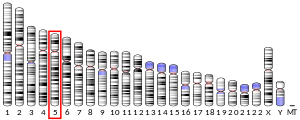PAIP1
Polyadenylate-binding protein-interacting protein 1 is a protein that in humans is encoded by the PAIP1 gene.[5][6][7]
| PAIP1 | |||||||||||||||||||||||||
|---|---|---|---|---|---|---|---|---|---|---|---|---|---|---|---|---|---|---|---|---|---|---|---|---|---|
| |||||||||||||||||||||||||
| Identifiers | |||||||||||||||||||||||||
| Aliases | PAIP1, poly(A) binding protein interacting protein 1 | ||||||||||||||||||||||||
| External IDs | OMIM: 605184 MGI: 2384993 HomoloGene: 4709 GeneCards: PAIP1 | ||||||||||||||||||||||||
| |||||||||||||||||||||||||
| |||||||||||||||||||||||||
| |||||||||||||||||||||||||
| Orthologs | |||||||||||||||||||||||||
| Species | Human | Mouse | |||||||||||||||||||||||
| Entrez | |||||||||||||||||||||||||
| Ensembl | |||||||||||||||||||||||||
| UniProt | |||||||||||||||||||||||||
| RefSeq (mRNA) | |||||||||||||||||||||||||
| RefSeq (protein) | |||||||||||||||||||||||||
| Location (UCSC) | Chr 5: 43.53 – 43.56 Mb | Chr 13: 119.43 – 119.46 Mb | |||||||||||||||||||||||
| PubMed search | [3] | [4] | |||||||||||||||||||||||
| Wikidata | |||||||||||||||||||||||||
| |||||||||||||||||||||||||
Function
The protein encoded by this gene interacts with poly(A)-binding protein and with the cap-binding complex eIF4A. It is involved in translational initiation and protein biosynthesis. Overexpression of this gene in COS7 cells stimulates translation. Alternative splicing occurs at this locus and three transcript variants encoding three distinct isoforms have been identified.[7]
Interactions
PAIP1 has been shown to interact with PABPC1.[5][8]
gollark: Ah, of course.
gollark: Oh no.
gollark: Also, tax evasion.
gollark: Also, wanting stupidly expensive recreational stuff.
gollark: Rich people wanting protection from extinction events?
References
- GRCh38: Ensembl release 89: ENSG00000172239 - Ensembl, May 2017
- GRCm38: Ensembl release 89: ENSMUSG00000025451 - Ensembl, May 2017
- "Human PubMed Reference:". National Center for Biotechnology Information, U.S. National Library of Medicine.
- "Mouse PubMed Reference:". National Center for Biotechnology Information, U.S. National Library of Medicine.
- Craig AW, Haghighat A, Yu AT, Sonenberg N (Apr 1998). "Interaction of polyadenylate-binding protein with the eIF4G homologue PAIP enhances translation". Nature. 392 (6675): 520–3. doi:10.1038/33198. PMID 9548260.
- Wiemann S, Weil B, Wellenreuther R, Gassenhuber J, Glassl S, Ansorge W, Böcher M, Blöcker H, Bauersachs S, Blum H, Lauber J, Düsterhöft A, Beyer A, Köhrer K, Strack N, Mewes HW, Ottenwälder B, Obermaier B, Tampe J, Heubner D, Wambutt R, Korn B, Klein M, Poustka A (Mar 2001). "Toward a catalog of human genes and proteins: sequencing and analysis of 500 novel complete protein coding human cDNAs". Genome Res. 11 (3): 422–35. doi:10.1101/gr.GR1547R. PMC 311072. PMID 11230166.
- "Entrez Gene: PAIP1 poly(A) binding protein interacting protein 1".
- Roy G, De Crescenzo G, Khaleghpour K, Kahvejian A, O'Connor-McCourt M, Sonenberg N (Jun 2002). "Paip1 interacts with poly(A) binding protein through two independent binding motifs". Mol. Cell. Biol. 22 (11): 3769–82. doi:10.1128/MCB.22.11.3769-3782.2002. PMC 133836. PMID 11997512.
Further reading
- Gray NK, Coller JM, Dickson KS, Wickens M (2000). "Multiple portions of poly(A)-binding protein stimulate translation in vivo". EMBO J. 19 (17): 4723–33. doi:10.1093/emboj/19.17.4723. PMC 302064. PMID 10970864.
- Grosset C, Chen CY, Xu N, Sonenberg N, Jacquemin-Sablon H, Shyu AB (2000). "A mechanism for translationally coupled mRNA turnover: interaction between the poly(A) tail and a c-fos RNA coding determinant via a protein complex". Cell. 103 (1): 29–40. doi:10.1016/S0092-8674(00)00102-1. PMID 11051545.
- Khaleghpour K, Svitkin YV, Craig AW, DeMaria CT, Deo RC, Burley SK, Sonenberg N (2001). "Translational repression by a novel partner of human poly(A) binding protein, Paip2". Mol. Cell. 7 (1): 205–16. doi:10.1016/S1097-2765(01)00168-X. PMID 11172725.
- Deo RC, Sonenberg N, Burley SK (2001). "X-ray structure of the human hyperplastic discs protein: an ortholog of the C-terminal domain of poly(A)-binding protein". Proc. Natl. Acad. Sci. U.S.A. 98 (8): 4414–9. doi:10.1073/pnas.071552198. PMC 31849. PMID 11287654.
- Roy G, De Crescenzo G, Khaleghpour K, Kahvejian A, O'Connor-McCourt M, Sonenberg N (2002). "Paip1 interacts with poly(A) binding protein through two independent binding motifs". Mol. Cell. Biol. 22 (11): 3769–82. doi:10.1128/MCB.22.11.3769-3782.2002. PMC 133836. PMID 11997512.
- Fortna A, Kim Y, MacLaren E, Marshall K, Hahn G, Meltesen L, Brenton M, Hink R, Burgers S, Hernandez-Boussard T, Karimpour-Fard A, Glueck D, McGavran L, Berry R, Pollack J, Sikela JM (2004). "Lineage-specific gene duplication and loss in human and great ape evolution". PLoS Biol. 2 (7): E207. doi:10.1371/journal.pbio.0020207. PMC 449870. PMID 15252450.
This article is issued from Wikipedia. The text is licensed under Creative Commons - Attribution - Sharealike. Additional terms may apply for the media files.



